CCR2 antagonist CCX140-B provides renal and glycemic benefits in diabetic transgenic human CCR2 knockin mice
- PMID: 23986513
- PMCID: PMC4073927
- DOI: 10.1152/ajprenal.00316.2013
CCR2 antagonist CCX140-B provides renal and glycemic benefits in diabetic transgenic human CCR2 knockin mice
Abstract
Chemokine (C-C motif) receptor 2 (CCR2) is central for the migration of monocytes into inflamed tissues. The novel CCR2 antagonist CCX140-B, which is currently in two separate phase 2 clinical trials in diabetic nephropathy, has recently been shown to reduce hemoglobin A1c and fasting blood glucose levels in type 2 diabetics. In this report, we describe the effects of this compound on glycemic and renal function parameters in diabetic mice. Since CCX140-B has a low affinity for mouse CCR2, transgenic human CCR2 knockin mice were generated and rendered diabetic with either a high-fat diet (diet-induced obesity) or by deletion of the leptin receptor gene (db/db). CCX140-B treatment in both models resulted in decreased albuminuria, which was associated with decreased glomerular hypertrophy and increased podocyte density. Moreover, treatment of diet-induced obese mice with CCX140-B resulted in decreased levels of fasting blood glucose and insulin, normalization of homeostatic model assessment of insulin resistance values, and decreased numbers of adipose tissue inflammatory macrophages. Unlike other CCR2 antagonists, CCX140-B had no effect on plasma levels of the CCR2 ligand CCL2 or on the numbers of blood monocytes. These results support the ongoing evaluation of this molecule in diabetic subjects with impaired renal function.
Trial registration: ClinicalTrials.gov NCT01440257 NCT01447147.
Keywords: albuminuria; chemokine; chemokine (C-C motif) receptor 2; hyperglycemia; macrophage.
Figures







References
-
- Aiello RJ, Perry BD, Bourassa PA, Robertson A, Weng W, Knight DR, Smith AH, Frederick KS, Kalgutkar A, Gladue RP. CCR2 receptor blockade alters blood monocyte subpopulations but does not affect atherosclerotic lesions in apoE(−/−) mice. Atherosclerosis 208: 370–375, 2010. - PubMed
-
- Banba N, Nakamura T, Matsumura M, Kuroda H, Hattori Y, Kasai K. Possible relationship of monocyte chemoattractant protein-1 with diabetic nephropathy. Kidney Int 58: 684–690, 2000. - PubMed
-
- Basak A, Charvat TT, Chen W, Dairaghi DJ, Hansen D, Jin J, Krasinski A, Moore J, Pennell A, Punna S, Ungashe S, Wei Z, Wang Q, Wright JJ, Zeng Y. Heteroaryl Sulfonamides and CCR2 (online). https://www.google.com/patents/US7622583 [9 September 2013].
MeSH terms
Substances
Associated data
Grants and funding
LinkOut - more resources
Full Text Sources
Other Literature Sources
Medical
Molecular Biology Databases
Miscellaneous

